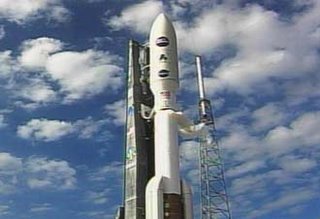
Spaced!
In part because it beats dealing with many things in daily life I've found myself becoming interested again in various developments in astronomy and space tech today.Over on Dwight Williams blog yesterday (though I didn't see it until this morning) he noted several pieces involving the discovery and speculation surrounding a "superbubble" of hydrogen erupting roughly 23,000 light years from Earth, out on another spiral arm of our Milky Way Galaxy. (Artist's conception up top.) The other links Dwight points out in his post take that information and run in interesting directions with it, including speculations on the importance of such an event in the evolution of life here on Earth.
 Also yesterday, Alibi pointed out the New Horizons mission, one of the many space missions which are either in progress or - as in this case - literally on the launchpad. (The next launch window is Thursday afternoon.) This will be another of those missions where the gap of time between the launch and the commencement of the primary mission will be years apart. Nine years, in this case, as it's no swift trip from Earth to the Kuiper Belt and then on to Pluto.
Also yesterday, Alibi pointed out the New Horizons mission, one of the many space missions which are either in progress or - as in this case - literally on the launchpad. (The next launch window is Thursday afternoon.) This will be another of those missions where the gap of time between the launch and the commencement of the primary mission will be years apart. Nine years, in this case, as it's no swift trip from Earth to the Kuiper Belt and then on to Pluto.And, yes, Alibi, I must agree that it does resemble a suppository though I'm not sure I would have made that leap without your assistance...
Next - and with an eye towards speedier, more efficient exploration of the Solar System - I see that the European Space Agency and the Australian National University have begun testing a prototype ion-drive engine that's roughly ten times as efficient as the current model being used by the ESA and achieves an exhaust plume of 210,000 meters/second, which is four times the output of current, state of the art ion engines. Much testing lies ahead, but so far it's very promising.
I've lacked the time today to dig up more technical details, such as the range of materials that can be used as fuel in these systems. Unlike traditional liquid rocket fuels, an ion engine doesn't need to burn a fuel, and so doesn't need to carry both a fuel and an oxygen source. In an ion engine the fuel source is electrically broken down - sifted, after a fashion - into ions which are electromagnetically accelerated down through the shaft of the rocket. This should theoretically enable a broader range of materials, possibly including various ices to be found on the moons of the giant planets in the outer reaches of the Solar System.
Finally, I'd be remiss in not noting that the Stardust mission has indeed returned particles from a comet to Earth. Part of me is now waiting for the dead to begin reanimating...
Comments